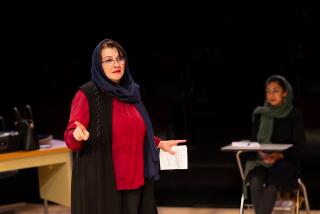India’s Curious Patois : A Language Not Quite Like English
- Share via
NEW DELHI — Some time ago, the Speaker of Britain’s House of Commons was entertained by his counterpart in India, the Speaker of the Lok Sabha, the House of the People.
The Indian invited the Englishman to attend a legislative session, and for two hours the guest sat in the gallery listening to the sometimes chaotic debate.
Occasionally there were lapses into a regional language--Telugu, Tamil, Bengali--but for the most part the business was conducted in English. Still, the Briton understood little of what he heard, and when he joined his host for lunch he said, “You know, your Indian language sounds very much like English.”
This story is told often by H.Y. Sharada Prasad, a senior adviser to Prime Minister Rajiv Gandhi. Like many in the Indian upper class, Prasad is a student of Indian English or, as he puts it, “the language written or spoken by Indians in the belief that it is English.”
Opaque to Outsiders
The British visitor’s failure to recognize his own language is not as strange as it might seem. English-speaking newcomers often have to strain to understand simple conversations in Indian English. Visiting journalists have been known to hire translators for interviews conducted in English. Longtime residents learn to change their speech patterns so as to be more easily understood.
Indian English--”Indish” as it is sometimes called--is in many respects very different from the English used in Britain or the United States. What is said in New Delhi or Calcutta, in what sounds like English, may mean something quite different in Liverpool or Detroit.
For example, where else but India do you take your damaged auto to a repair shop to be “dented?” Where else do marriageable women advertise in the newspapers for “boy-looking, handsome husbands,” or men for “thin, wheatish, homely girls?”
Surely, there is no other place where two men greet each other:
“How are you I hope?”
“O yes.”
National Languages
With a population of almost 800 million, India has more people with a working knowledge of English than any other country except the United States and Britain. English is one of the officially recognized national languages, along with Hindi. According to Sharada Prasad, 90% of the work of the government of India is done in English.
Because India is made up of regions and states that have languages of their own, the English used their language, along with the national railway system, to connect the diverse parts. India is still a land of language rivalry, and English, the second language for most Indians, is still the common language, the neutral language, the peacemaker.
English is also the tongue of status and achievement. Upwardly mobile, middle-class Indians want their children to speak English, preferably with crisp Oxford enunciation.
“India may have constitutionally ceased to be part of the empire,” Sharada Prasad observed in an essay on Indian English, “but culturally and intellectually it is still very much part of the English-speaking world.”
At the highest levels of educated Indian society, English is spoken with intimidating perfection. Proper English-speaking Indians, in fact, cringe at the sound of the English spoken by many Americans.
A number of the world’s finest writers in English today, including Salman Rushdie, R.K. Narayan and Ved Mehta, are Indian. So is one of the current rages of the American literary scene, the 34-year-old Stanford graduate student Vikram Seth.
Seth’s new novel, “Golden Gate,” is set in Northern California and written in iambic tetrameter. It has received glowing reviews.
Despite these accomplishments in the world of standard English, India’s own version of the language has acquired a peculiarly South Asian character. Nearly 400 years after English was introduced on the subcontinent, the language heard on the streets of Bombay and in the dormitories of Delhi University is not the language heard in London, Sydney or Santa Monica.
‘Around With My Auntie’
Consider the following exchange between two women students at Delhi University, which was recorded by Peter J. Kwiatek, an American who for the last five years has studied Indian languages at the Delhi University linguistics department:
“What you did in Delhi?”
“Oh, generally we moved around with my auntie. My cousin-sister was out of station and my cousin-brother was sitting for his exams.”
“Too boring, yar!”
“You went to see some play-shay?
“Come on, yar. Auntie-ji is so much conservative. She won’t let me move alone in buses, and scooties are too expensive.”
“At least you would have met three-four friends, na? Your unkie could have reached you to their colonies?”
“Ufo! Uncle-ji gets damn hassled when you ask him for ride-shides. You know he has a hard-hard job and does not like to drive after office.”
This is understandable to the listener who knows that “cousin-brothers” and “cousin-sisters” are first cousins, that “out of station” means away from home, that “yar” is a common Hindi expression that means “friend,” that “scooties” are the three-wheel taxis found in most Indian cities, that “na” is a simple interrogative, that “ufo” is like oh-- an expression of mild dismay, and that “ji” is an honorific denoting respect and politeness.
Musical, After a Fashion
The rhyming echo, as in “play-shay,” and the repetition, as in “hard-hard,” also sound alien to American and British ears. These derive from patterns that occur in Indian languages, and their use lends the language a sort of sing-song quality.
In English, these almost sing-song patterns can be amusing. Sharada Prasad offers an example: “Different, different people, you are remembered, have different, different tastes.”
At times, this practice approaches a lyrical beauty that reflects the poetic qualities of the mother tongues, particularly Urdu and Bengali. From the Indian writer Raja Rao:
“Hot, hot tea . . . long, long hair. . . . With these very eyes, with these very eyes, I have seen the ghosts of more than a hundred young men and women, all killed by magic, by magic.”
Indian English sometimes echoes a courtly formality and graciousness that hark back to the days of Mogul emperors and princes. A clerk will ask, “May I know your good name?” A stranger on a train may ask, “How manyeth son are you to your father?” A child may ask another, “What is your happy birthday?”
Enough Obfuscation
In writing, this penchant for politesse sometimes prompts the reader to wish that the writer would simply get to the point. Letters received by the prime minister are sometimes couched in language that might be addressed more fittingly to some potentate of the past. Here is one from a man lobbying for open-pit mine workers:
“We consider it our pious duty for taking humble liberty while putting forward our suave submission taking away few precious moments of these times overburdened with various other more important national as well as international problems being dealt with the highest order of perspicuousness, a rare evergreen divine gift adorned on His Excellency. In the past, many a dignitary of our country had been considerate and kind enough to irrigate encouraging feelings and moods to our hard-working laborers. . . .”
Indish is a treasury of archaic and hackneyed expressions long out of vogue in other English-speaking countries. Work, for example, is never hard but often “arduous.” An Indian seldom votes; he “exercises his franchise.”
“It is a nice repository for words that have become obsolete in modern English,” according to the scholar Kwiatek.
Archaic Journalese
Archaic words turn up regularly in crime reports in English-language newspapers. “Miscreants” and “desperadoes” commit “dastardly deeds” and “abscond with the loot.”
While India has accepted English, it has at the same time contributed a long list of words to English, among them atoll, avatar, bangle, bungalow, calico, chintz, cummerbund, dinghy, dungarees, gingham, jodhpurs, juggernaut, jungle, khaki, loot, mogul, pariah, polo, pundit, pajamas, shampoo, shawl, thug, toddy and veranda.
Ninety years ago, Mark Twain had some fun in a letter to his friend Rudyard Kipling, who was born in Bombay. Misusing one adopted Indian word after another, he wrote:
“I shall arrive next January, and you must be ready. I shall come riding my ayah (governess), with his tusks adorned with silver bells and ribbons, and escorted by a troop of native howdahs (seats on elephants), richly clad and mounted upon a herd of wild bungalows, and you must be on hand with a few bottles of ghee (clarified butter), for I shall be thirsty.”
Words Without Equivalents
No matter how much English has been influenced by Indian languages, the influence of English on the languages of India has probably been stronger. For example, Indian scholars have tried to find a Hindi word for train, but the five-word phrase they have come up with ( laoh path maminee vasp-chalika-- “steam vehicle that goes on iron road”) has never caught hold among the Indians.
Nor has “stick that smokes” replaced cigarette. And table tennis has still to be supplanted by “a ball bounces on a wooden plank and bounces back.”
One of the main reasons for the peculiarities of Indian English is its relative isolation from the rest of the English-speaking world. Very few English-language movies are brought in, mainly because of restrictions aimed at protecting the Indian film industry.
Only one foreign television show, a British educational program about anatomy, is seen here. And Western music, classical and popular, has never been widely heard because India has its own rich musical traditions.
Tongue of the Elite
Despite the impact of English, there is no danger of its becoming the primary language in India, except within the small community of the urban elite. Almost all the Indian languages have strong literary traditions, and as the champion of Indian independence, Mohandas K. Gandhi, often boasted, nearly all Indians are multilingual. For many people, English is not even the second language but the third or fourth.
Regional languages have made for regional varieties of Indian English--”108 varieties,” the Indian economist Dharma Kumar once said, though her view is that most foreigners think of Indian English as “Peter Sellers imitating an Indian.”
Sharada Prasad, describing the different forms of Indian English, said: “In Hyderabad, you go to the jhoo (zoo). In Pune, you are vhery, vhery sorry. In Bangalore, you knock your head againesht the wall. In Calcutta, the bus you miss is often referred to as the boss. “
Regional languages keep feeding Indian English, so that in the streets of the cities, in Parliament, in the popular Bombay movie magazines, the language is a confounding mix of Indian and English-- masala English, they call it here, “spicy English.”
The Indian poet Keki Daruwalla said of Indian English, which he referred to as his “half-caste mistress”:
You can make her out the way she speaks;
Her consonants bludgeon you.
Her argot is rococo, her latest slang
Is available in classical dictionaries.
More to Read
Sign up for Essential California
The most important California stories and recommendations in your inbox every morning.
You may occasionally receive promotional content from the Los Angeles Times.












